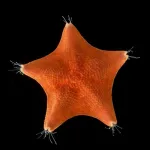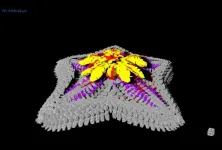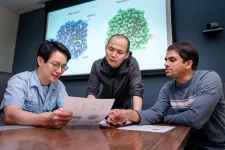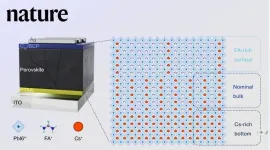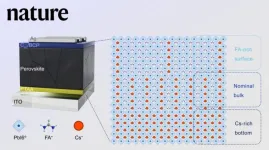(Press-News.org) New research combining computer modeling and experiments with macaques shows the body’s immune system helps control human immunodeficiency virus (HIV) infections largely by suppressing viral production in already infected cells while also killing viral infected cells, but only within a narrow time window at the start of a cell’s infection.
“To eliminate HIV, we have to understand how the immune system attempts to control the infection,” said Ruy M. Ribeiro, a theoretical biologist at Los Alamos National Laboratory who led the development of the model underpinning the research. Ribeiro is the corresponding author of the paper about the findings, published in Nature Communications.
The research team included Los Alamos Senior Fellow Alan S. Perelson and a former Los Alamos postdoctoral researcher now at the Fred Hutchinson Cancer Research Center. Their collaborators at the University of Pittsburg managed the experiments with macaques infected with simian immunodeficiency virus (SIV) to validate the model. SIV infections in monkeys behaves the same way as HIV in humans.
Helping the immune system attack HIV
“The immune system can’t eliminate an HIV infection,” Ribeiro notes, “but pinpointing the existing mechanism by which it is to some extent controlling HIV is very important for designing treatments to enhance that mechanism. If we can modulate the immune system to help control HIV better, we may be able to cure the disease at some point.”
Under the overall leadership of Perelson, Los Alamos has been a global leader in modeling viral infections, including HIV, since the mid-1990s. For the Nature Communications paper, the research team extended a mathematical model published in 2017 by Ribeiro and others at Los Alamos that simulates the interactions and lifecycle of cells that will be infected, already infected cells and the virus.
The new model also simulates the potential effects of the immune response, which include killing the cells, generating proteins that suppress the production of virus or helping mount a defense that prevents the virus entering cells.
Resolving an open question about HIV
Specifically focused on a kind of immune response mediated by CD8+ T cells, the research resolved an open question in HIV research: Do these T cells control HIV by killing HIV cells or by triggering human cells to deploy defenses against the infection?
“There’s been controversy about whether this type of T cell controls infection by killing infected cells or by somehow controlling the virus without killing infected cells, so we’re trying to distinguish these possibilities and mechanisms,” Ribeiro said.
The answer turned out to be “a little of both.”
To isolate the role of the T cells, the Los Alamos team ran the model to predict the effects of treating groups of infected macaques variously with antibodies and antiviral drugs.
Some macaques were treated with a drug designed to prevent infection by blocking the virus from integrating into the DNA of the macaques’ cells. This drug, called an integrase inhibitor, “revealed the dynamics of the early part of the virus lifecycle that we couldn’t easily see with other types of treatment,” Ribeiro said. “It’s as if we used a microscope.”
Other macaques were treated with an antibody that depletes the CD8+ T cells, eliminating their role in fighting the infection. A third cohort of macaques received both treatments.
The Los Alamos team then ran the model to analyze the macaque data to determine the effects of the different immune responses. From the model they inferred the most relevant immune mechanisms that more closely described the observed data.
END
Pinpointing HIV immune response
Refined understanding of T cells’ action in the body’s battle against the AIDS-causing virus will help improve treatments
2023-11-01
ELSE PRESS RELEASES FROM THIS DATE:
First mice engineered to survive COVID-19 like young, healthy humans
2023-11-01
Researchers have genetically engineered the first mice that get a human-like form of COVID-19, according to a study published online November 1 in Nature.
Led by researchers from NYU Grossman School of Medicine, the new work created lab mice with human genetic material for ACE2 – a protein snagged by the pandemic virus so it can attach to human cells as part of the infection. The mice with this genetic change developed symptoms similar to young humans infected with the virus causing COVID-19, instead of dying ...
As people live longer, family caregivers face financial challenges
2023-11-01
PHILADELPHIA (November 1, 2023) – Many people overlook the short- and long-term costs of financial caregiving, a growing problem that financial advisors and employers can help address, according to a new report by the TIAA Institute and the University of Pennsylvania School of Nursing (Penn Nursing).
One in five adults now provide uncompensated care to loved ones with health problems, and the report provides a comprehensive compilation of insights and research that underscores how the caregivers face a ...
Human mini guts reveal new insights into the process leading to Cronkhite-Canada syndrome and potential new therapies
2023-11-01
Researchers at Baylor College of Medicine and collaborating institutions working with human intestinal organoids, also called mini guts, have shed new light on the potential causes of Cronkhite-Canada syndrome, a rare condition characterized by abundant non-cancerous growths or polyps in the intestine and other symptoms such as hair and nail loss and changes in skin pigmentation. Published in The Journal of Clinical Investigation, the study is the first to show a connection between high polyp proliferation and increased levels of serotonin produced by the intestinal epithelium.
The findings suggest a potential new approach to treat this disease with serotonin ...
Long presumed to have no heads at all, sea stars may be nothing but
2023-11-01
For centuries, naturalists have puzzled over what might constitute the head of a sea star, commonly called a “starfish.” When looking at a worm, or a fish, it’s clear which end is the head and which is the tail. But with their five identical arms — any of which can take the lead in propelling sea stars across the seabed — it’s been anybody’s guess how to determine the front end of the organism from the back. This unusual body plan has led many to conclude that sea stars perhaps don’t have a head at all.
But ...
Starfish body is a head, say scientists
2023-11-01
EMBARGOED: Not for Release Until 01 November 2023 at 16:00 (London time)
The bodies of starfish and other echinoderms are more like heads, according to new research involving the University of Southampton.
The research, published today [1 November] in Nature, helps to answer the mystery of how these creatures evolved their distinctive star-shaped body, which has long puzzled scientists.
Echinoderms are a group of animals that includes starfish (or sea stars), sea urchins, and sand dollars. They have a unique ‘fivefold symmetric’ body plan, which means ...
Scientists reveal structures of neurotransmitter transporter
2023-11-01
(Memphis, Tenn – November 1, 2023) Neurons talk to each other using chemical signals called neurotransmitters. Scientists at St. Jude Children’s Research Hospital have drawn on structural biology expertise to determine structures of vesicular monoamine transporter 2 (VMAT2), a key component of neuronal communication. By visualizing VMAT2 in different states, scientists now better understand how it functions and how the different shapes the protein takes influence drug binding — critical information for ...
Heterogeneity of Earth’s mantle may be relics of Moon formation
2023-11-01
An interdisciplinary international research team has recently discovered that a massive anomaly deep within the Earth’s interior may be a remnant of the collision about 4.5 billion years ago that formed the Moon.
This research offers important new insights not only into Earth’s internal structure but also its long-term evolution and the formation of the inner solar system.
The study, which relied on computational fluid dynamics methods pioneered by Prof. DENG Hongping of the Shanghai Astronomical Observatory (SHAO) of ...
Study reveals location of starfish’s head
2023-11-01
If you put a hat on a starfish, where would you put it? On the center of the starfish? Or on the point of an arm and, if so, which one? The question is silly, but it gets at serious questions in the fields of zoology and developmental biology that have perplexed veteran scientists and schoolchildren in introductory biology classes alike: Where is the head on a starfish? And how does their body layout relate to ours?
Now, a new Stanford study that used genetic and molecular tools to map out the body regions of starfish – by creating a 3D atlas of their gene ...
Scientists propose perovskite films homogenizing strategy to increase conversion efficiency
2023-11-01
In a study published in Nature, researchers from the Hefei Institutes of Physical Science (HFIPS) of the Chinese Academy of Sciences have proposed a new and promising method of fabricating homogenized perovskite films for solar cells. The process involves inhibiting phase segregation caused by internal cation inhomogeneity to increase conversion efficiency to 26.1%, thus tying the existing record.
Their work was also featured as a Nature Editor’s Pick.
For solar cells, an important alternative energy ...
Scientists propose perovskite film homogenizing strategy to increase conversion efficiency
2023-11-01
In a study published in Nature, researchers from the Hefei Institutes of Physical Science (HFIPS) of the Chinese Academy of Sciences have proposed a new and promising method of fabricating homogenized perovskite films for solar cells. The process involves inhibiting phase segregation caused by internal cation inhomogeneity to increase conversion efficiency to 26.1%, thus tying the existing record.
Their work was also featured as a Nature Editor's Pick.
For solar cells, an important alternative energy source, the pursuit of higher conversion efficiency and the attempt to keep the cells table as long as possible are core issues that scientists and engineers all over the world are ...
LAST 30 PRESS RELEASES:
Heart-brain connection: international study reveals the role of the vagus nerve in keeping the heart young
Researchers identify Rb1 as a predictive biomarker for a new therapeutic strategy in some breast cancers
Survey reveals ethical gaps slowing AI adoption in pediatric surgery
Stimulant ADHD medications work differently than thought
AI overestimates how smart people are, according to HSE economists
HSE researchers create genome-wide map of quadruplexes
Scientists boost cell "powerhouses" to burn more calories
Automatic label checking: The missing step in making reliable medical AI
Low daily alcohol intake linked to 50% heightened mouth cancer risk in India
American Meteorological Society announces Rick Spinrad as 2026 President-Elect
Biomass-based carbon capture spotlighted in newly released global climate webinar recording
Illuminating invisible nano pollutants: advanced bioimaging tracks the full journey of emerging nanoscale contaminants in living systems
How does age affect recovery from spinal cord injury?
Novel AI tool offers prognosis for patients with head and neck cancer
Fathers’ microplastic exposure tied to their children’s metabolic problems
Research validates laboratory model for studying high-grade serous ovarian cancer
SIR 2026 delivers transformative breakthroughs in minimally invasive medicine to improve patient care
Stem Cell Reports most downloaded papers of 2025 highlight the breadth and impact of stem cell research
Oxford-led study estimates NHS spends around 3% of its primary and secondary care budget on the health impacts of heat and cold in England
A researcher’s long quest leads to a smart composite breakthrough
Urban wild bees act as “microbial sensors” of city health.
New study finds where you live affects recovery after a hip fracture
Forecasting the impact of fully automated vehicle adoption on US road traffic injuries
Alcohol-related hospitalizations from 2016 to 2022
Semaglutide and hospitalizations in patients with obesity and established cardiovascular disease
Researchers ‘listen in’ to embryo-mother interactions during implantation using a culture system replicating the womb lining
How changing your diet could help save the world
How to make AI truly scalable and reliable for real-time traffic assignment?
Beyond fragmented markets: A new framework for efficient and stable ride-pooling
Can shape priors make road perception more reliable for autonomous driving?
[Press-News.org] Pinpointing HIV immune responseRefined understanding of T cells’ action in the body’s battle against the AIDS-causing virus will help improve treatments

